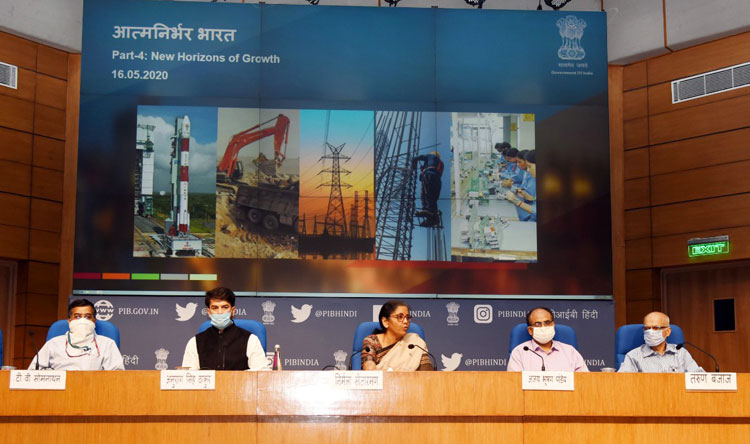INDIAN ARMED FORCES CHIEFS ON
OUR RELENTLESS AND FOCUSED PUBLISHING EFFORTS

SP Guide Publications puts forth a well compiled articulation of issues, pursuits and accomplishments of the Indian Army, over the years

I am confident that SP Guide Publications would continue to inform, inspire and influence.

My compliments to SP Guide Publications for informative and credible reportage on contemporary aerospace issues over the past six decades.
New Direction in Defence Production and Procurement
 |
The Author is Former Director General of Information Systems and A Special Forces Veteran, Indian Army |

Delivering the fourth tranche of the economic package in wake of COVID-19 in a press briefing on May 16, Finance Minister Nirmala Sitharaman announced three major decision related to defence which will have far reaching effect in boosting the defence sector;
- one, corporatisation of the Ordnance Factory Board (OFB) clarifying that corporatisation does not imply privatisation;
- two, hiking Foreign Direct Investment in defence, and;
- three, banning defence imports where indigenous capability exists.
The OFB comprises 41 Ordnance factories, nine training institutes, three Regional Marketing Centres and four Regional Controllers of Safety. It is subordinate to the Department of Defence Production (DoDP) under the Ministry of Defence (MoD). OFB has 82,000 employees and holds over 60,000 acres of land. More than 80 per cent orders for OFB come from the Army though OFB barely meets 50 per cent of Army requirements. OFB's archaic structure is not conducive to productivity. Every decision from modernising plant and machinery to entering joint ventures is subject to regulations and red tape, reducing leverage and flexibility needed by any dynamic production unit. In addition is the lack of technical and managerial flexibility, making competition with private industry difficult. There is little scope for innovation and modernisation within the existing structure. Accountability and the lackadaisical work culture leave much to desire.
High cost of OFB products is due to high overhead charges and there is minimal innovation and technology development. In the past, three government committees had suggested corporatising OFB: TKA Nair Committee (2000) recommended converting OFB to Ordnance Factory Corporation Limited; Vijay Kelkar Committee (2004 recommended corporatisation with 'NavRatna' status, like BSNL; and Vice Admiral Raman Puri Committee (2015) recommended corporatising OFB and splitting it into 3-4 segments - each specialising in distinct area like weapons, ammunition and combat vehicles. This is not the first time government has shown resolve to corporatise the OFB. Arun Jaitley as Finance Minister made some moves towards this but faced opposition from worker unions. In August 2019, government announced the decision to corporatise OFB, following which 60,000 OFB employees struck work for a month. The strike was finally called off by the Confederation of Defence Registered Associations comprising multiple unions affiliated to political parties. On September 17, 2019, MoD set terms of reference for a high-level committee to address concerns raised by the workers federations. However, latter raised further apprehensions about Centre’s aim behind corporatising OFB. The federation went on another six-day strike but their main apprehension was that government wants to privatise OFB. This fear of privatisation has been allayed by the Finance Minister now, with control retained by MoD. Corporatising will help increase productivity, self-reliance plus advanced technologies and innovations. The challenge will be how quickly and holistically the change is affected. Media reports of February 2018 cited a presentation given by MoS (Defence) Subhash Bhamre to PM Modi that acquisitions and `Make in India’ was floundering due to multiple and diffuse structures with no single-point accountability, duplication of processes, avoidable redundant layers, delayed execution, no real-time monitoring and no project-based approach. This attitude must change with OFB remaining under MoD. If OFB and DPSUs are to compete with private industry in a level playing field, all the more OFB must quickly corporatise in early time frame.
Government perhaps will also permit FDI in entities of OFB, as also joint ventures as in the case of production if AK-203 assault rifles in collaboration with Russia. Hike in FDI limit in the defence sector to 74 per cent from existing 49 per cent automatic route is to tide over the economic slowdown because of COVID-19 lockdown. This should have happened much earlier with the Department of Industrial Policy and Promotion (DIPP) of the Ministry of Commerce and Industry recommending even before 2014, 74 per centFDI in case of Transfer of Technology (ToT) and 100 per cent FDI in case of making available state of the art technology. The result has been that as of December 2019, the total FDI inflows in India’s defence sector in the last five years remained at a low of just $2.48 million and total FDI inflows in the last two decades (April 2000 to December 2019) which too remained at abysmally low level of just $8.82 million (Rs 52 crore). Had the recommendation of DIPP been implemented in 2014, it would have accelerated development of the Tejas fighter with more production lines established through joint ventures (JVs), and same for other equipment including helicopters, transport aircraft, weapon platforms and other defence equipment.FDI limit hike to 74 per centwill attract foreign firms and provide a boost to the ‘Make in India’. However, it would be prudent to also take a closer look and review/refine related issues for making defence sector more attractive to foreign firms, where required.
We also need to examine why foreign firms relocating from China because of COVID-19 prefer Vietnam and Indonesia, not India.With hike in FDI limit to 74 per cent and foreign firms senior partner in JVs, two issues will need to be streamlined: one, blocking FDI by China in defence sector ‘at least’ till the border is settled, demarcated and China demits to ‘One India’ policy, and; when control is with foreign entities, they should not sell products and transfer technology to our adversaries. Ban on defenceimports where indigenous products are available too is good move, In terms of defence acquisitions, the list for equipment where imports will not be allowed is under preparation. Where indigenous products are not available or development years away, essential imports will obviously continue. At the same time there is need to lay down a time-table for indigenisation, without which we will land up in the same rut as earlier with vested elements continuing imports and surreptitiously delaying indigenous production and advancements. There is no doubt that ban on defence imports will give a boost to indigenous defence firms like L&T, Bharat Forge, Bharat Electronics, BEML and the likes. But two issues the government needs to consider: one, will the orders already booked by indigenous companies like these be allowed to go through and if not, the financial impact on this account on them, and; two, parts and components by such companies import for their products – will these be permitted or they need to look at indigenous sources available but not in collaboration, which may cause disruptions. With all the havoc by COVID-19, it provides an opportunity to become ‘Atma Nirbhar’ as the Prime Minister has stressed.





